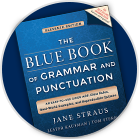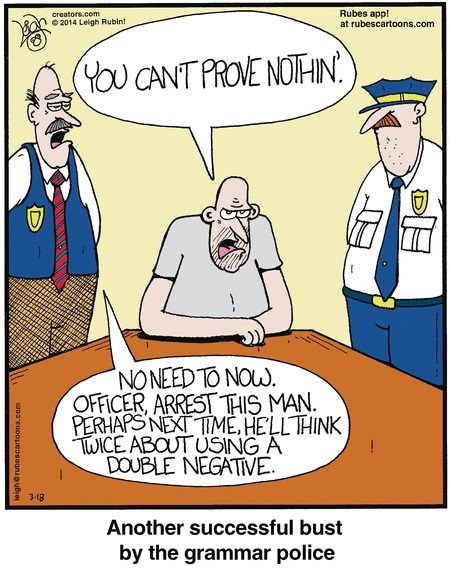Navigating Negative Constructions
|
|
The negative construction in English: We need it to state something is
incorrect or not true. For example, if we look into a clear sky, we have
the verbal component to express It is not raining.
At the same time, English teachers and communication coaches will advise us
to use negative constructions with care and restraint for a reason.
Negative constructions can make us work harder at comprehension; they can
also trigger subconscious resentment or resistance, as well as be
unhelpful, as we’ll see in a moment. When receiving information, our
minds are more naturally wired to receive positive constructions.
Examples
(Negative) Do not use the main entrance when entering the facility. (Beyond
being a negative construction, it leaves open the question of how to enter
the facility.)
(Positive) Use the side doors when entering the facility.
(Negative) She does not often talk at parties.
(Positive) She’s typically quiet at parties.
(Negative) Your main point shouldn’t be in the final paragraph. (Where
then should it go?)
(Positive) Place your main point near the beginning.
The differences between negative and positive statements about the same
idea are clear. The positive achieves more, many times with fewer words.
As mentioned, we will still sometimes need negative constructions to
identify what is incorrect or not true. We simply want to be aware of some
of their pitfalls. Let’s review one area of the negative many of us
are familiar with.
Is It True—or Isn’t It?
By now we’ve probably seen both live and fictionalized courtroom
proceedings in which attorneys ask a question such as “Is it not true
you were in the vehicle involved in the hit and run?”
This exemplifies how including a negative can make an expression evasive or
slippery. Is someone being asked to tell the truth or the not-truth? The
subject could provide different responses:
Response: No, it’s true. I was in the vehicle.
Response: Yes, it’s true I was in the vehicle.
Easy enough, it might seem, but the negative construction forces the
subject to think more than if simply asked “Were you in the vehicle
involved in the hit and run?” To this, the subject could just say
“yes” or “no.” The simpler question also requires
fewer words.
In addition, the question as posed by the attorney can leave room for the
subject to be elusive because a negative statement has already been
offered.
Response: Yes, it is not true. I was not in the vehicle.
Response: No, it’s not true I was in the vehicle.
It’s possible this wordplay by the attorney can be a subtle ploy to press or corner the matter of truth by clouding intent with the
negative: further proof that the mind works harder and gets confused
without the positive form. A question posed negatively could even work
subliminally on a juror’s mind by suggesting the subject is skirting
the truth.
In writing as in life, the negative is sometimes necessary and unavoidable.
In our daily discourse, however, such constructions may steer us away from
clarity and efficiency if used and relied on too much. By keeping
composition positive in form, we will promote more-effective message
delivery and comprehension.
|
View and comment on this
article on our website.
|
|
Pop Quiz
Using what you've learned in this article, choose the better sentence
from each pair.
1a. We can see hardly anything through the fog.
1b. We can't see hardly nothing through the fog.
2a. I agree with you.
2b. I don't disagree with what you're saying.
3a. Trey told Tina not to overcook the eggs.
3b. Trey told Tina to boil the eggs for five minutes.
4a. Is it not true that you stayed out an hour past curfew?
4b. Did you stay out an hour past curfew?
|
Free BONUS Quiz for You!
[[firstname]], because you are a subscriber to the newsletter, you get access to one of the Subscribers-Only Quizzes. Click here to take an Effective Writing Quiz and get your scores and explanations instantly!
We will be adding many more quizzes this year to our already substantial list of quizzes. If you have suggestions for topics we have not yet covered, please send us a message at help@grammarbook.com.
|
Hundreds of Additional Quizzes
at Your Fingertips
Subscribe now to receive hundreds of additional English usage quizzes not found anywhere else!
Teachers and Employers
Save hours of valuable time! You may assign quizzes to your students and employees and have their scores tallied, organized, and reported to you! Let GrammarBook.com take the hassle out of teaching English!
"Fun to test my skills."
"The explanations really help ... thanks!"
"I can select the quizzes to assign to my students, and then the results are reported to me automatically!"
|

|
Don't need all the quizzes?
You can now purchase the same quizzes individually for ONLY 99¢ each.
Purchase yours here. |
If you think you have found an error in a quiz, please email us at help@grammarbook.com
|
 |
The Blue Book of Grammar and Punctuation
by Jane Straus, Lester Kaufman, and Tom Stern |
The Authority on English Grammar! Eleventh Edition Now Available
An indispensable tool for busy professionals, teachers, students, homeschool families, editors, writers, and proofreaders.
Available in print AND as an e-Book! Over 2,000 copies are purchased every month!
The publisher of The Blue Book, Jossey-Bass, A Wiley brand, is offering a 35 percent discount for those of you who order the book through Wiley.com. Shipping and tax are not included. Simply go to bit.ly/1996hkA and use discount code E9X4A.
Offer expires December 31, 2020.
|
Wordplay

Pop Quiz Answers
1a. We can see hardly anything through the fog.
1b. We can’t see hardly nothing through the fog.
2a. I agree with you.
2b. I don't disagree with what you’re saying.
3a. Trey told Tina not to overcook the eggs.
3b. Trey told Tina to boil the eggs for five minutes.
4a. Is it not true that you stayed out an hour past curfew?
4b. Did you stay out an hour past curfew?
|
 |
English In A Snap:
68 One-Minute English Usage Videos FREE |
Learn all about who and whom, affect and effect, subjects and verbs, adjectives and adverbs, commas, semicolons, quotation marks, and much more by just sitting back and enjoying these easy-to-follow lessons. Tell your colleagues (and boss), children, teachers, and friends. Click here to watch.
|
|





